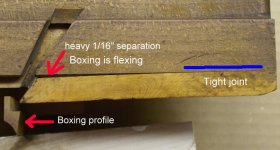David Conley
Well-known member
Everyone,
I just got a match set of snipe molding planes that I plan to use. However, the hide glue between the boxing and the plane body is in various states of failure. On the first plane, I was able wiggling the front and back pieces of boxing out of the plane. On the second plane, I was only able to pull out the front piece of boxing. The hide glue is probably 70 % failed on the remaining piece of boxing (see photograph). The problem is that it caused a heavy 1/16 inch separation between the boxing and the plane right on the bed of the blade. This piece of boxing is also flexing up and down as you place pressure on the plane. So, I have to repair it.
I do not expect it would take much to reverse the hide glue and free the boxing. My question to the group is: how do I reverse the glue and NOT warp the plane in the process?
In 2007, there was a post Re: Reversing Hide Glue in the Conservation and Furniture Repair section of this forum, I saw several methods mentioned.
1) If you did not clamp the joint, i.e just "rubbed on" the knee block, the glue joint will be weaker than the surrounding wood. You can usually tap it off with a hammer or lever it off with a clamp.
2) Apply heat with heat lamp or heat gun. This will often soften the glue enough to remove the knee block. Avoid getting nearby joints hot.
3) Steam the joint. This won't hurt the wood but if the steam gets to nearby joints on the leg they too may loosen.
4) Drill a large hole through the knee block stopping just past the joint line. Fill the hole with alcohol/acetone or even water. This will usually loosen the joint.
5) If you heat up the joint just a bit you may use a syringe filled with alcohol and inject it into the joint. I have had good success with this process. In addition, you will not loosen other joints that are nearby.?
I tried the #1 method on this plane and knocked the front boxing loose. I could not free the back boxing.
I am tempted to try method #2 by placing the plane on top of my glue pot for a couple of minutes. If that does not work, I am planning to try method #5 by placing some alcohol in the open joints.
Am I on the right track?
Thanks in advance,
David
I just got a match set of snipe molding planes that I plan to use. However, the hide glue between the boxing and the plane body is in various states of failure. On the first plane, I was able wiggling the front and back pieces of boxing out of the plane. On the second plane, I was only able to pull out the front piece of boxing. The hide glue is probably 70 % failed on the remaining piece of boxing (see photograph). The problem is that it caused a heavy 1/16 inch separation between the boxing and the plane right on the bed of the blade. This piece of boxing is also flexing up and down as you place pressure on the plane. So, I have to repair it.
I do not expect it would take much to reverse the hide glue and free the boxing. My question to the group is: how do I reverse the glue and NOT warp the plane in the process?
In 2007, there was a post Re: Reversing Hide Glue in the Conservation and Furniture Repair section of this forum, I saw several methods mentioned.
1) If you did not clamp the joint, i.e just "rubbed on" the knee block, the glue joint will be weaker than the surrounding wood. You can usually tap it off with a hammer or lever it off with a clamp.
2) Apply heat with heat lamp or heat gun. This will often soften the glue enough to remove the knee block. Avoid getting nearby joints hot.
3) Steam the joint. This won't hurt the wood but if the steam gets to nearby joints on the leg they too may loosen.
4) Drill a large hole through the knee block stopping just past the joint line. Fill the hole with alcohol/acetone or even water. This will usually loosen the joint.
5) If you heat up the joint just a bit you may use a syringe filled with alcohol and inject it into the joint. I have had good success with this process. In addition, you will not loosen other joints that are nearby.?
I tried the #1 method on this plane and knocked the front boxing loose. I could not free the back boxing.
I am tempted to try method #2 by placing the plane on top of my glue pot for a couple of minutes. If that does not work, I am planning to try method #5 by placing some alcohol in the open joints.
Am I on the right track?
Thanks in advance,
David

